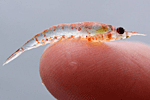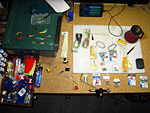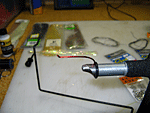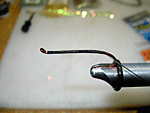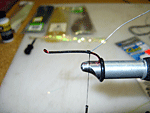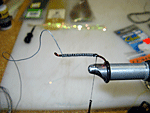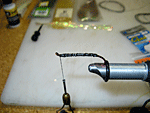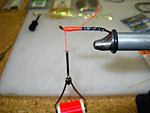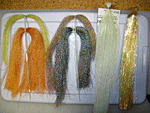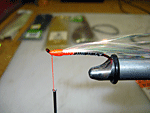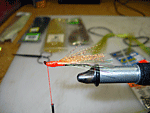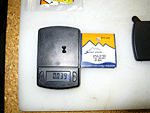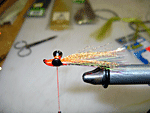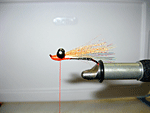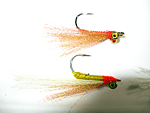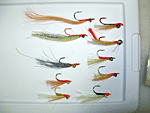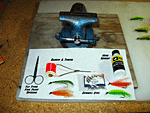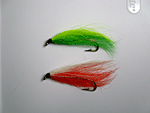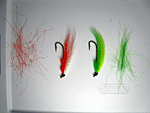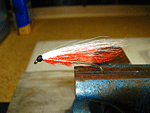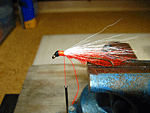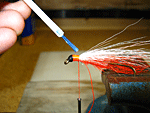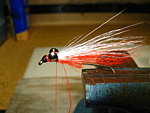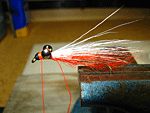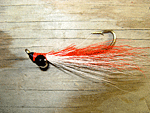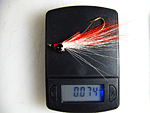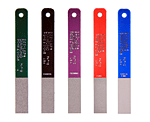~Klondike Kid~ 
|
|
The debate has gone on now for FIFTY YEARS and counting. Do sockeye salmon in freshwater strike any lure, bait, or fly so that anglers can catch them legally in the mouth? Some folks swear the only way to catch them in the mouth is to line them which means presenting your fly in a manner that the leader will drift in the gap of an open mouth and then as you pull or retrieve your fly it will end up in the fish's jaw for a legal hook up.
Then there are those like myself who KNOW sockeye will and do strike certain tackle. Every few years the sockeye run on the Kenai River will exhibit an unsual tendency to grab kwikfish lures trolled for Kings and grab Pixie spoons cast by riverbank anglers. These are fish that grab and even swallow those lures making it guaranteed they struck those lures and not by accident. Fish after fish will be hauled in on pixies in one of those years. Then nothing for several years' of returns. But its a pattern that is repeated over and over again in the 45 years I have watched the Kenai. I believe this non-typical sockeye response may be due to these particular age group of fish having spent more time feeding on small sandlance/needlefish, hooligan and juvenile herring than on the crustacean/krill menu. It makes sense. I am also one of those in the category of believers who know sockeye will readily and frequently strike at or grab a streamer fly (Coho fly as they are referred to) drifted within the stimulus response zone. There is no better place to observe this and verify this than the clearwaters of the Russian River where you can find a good riffle and sight fish individual salmon moving upstream. A perfectly timed cast with a swing drift crossing within a foot of the fish's head will frequently result in a strike and hook up. You can actually watch them turn towards the fly and grab it. Its a reflex response from years of feeding in the ocean no different than our four other species of Pacific salmon striking flies, spinners, spoons, and lures which immitate food they have been eating. Or it may just trigger that "grab it" reflex when it is near enough to invade their "comfort zone." I'm not going to convince those Sockeye Snaggers even if I stuck their heads underwater and they witnessed for themselves firsthand. They are intent to fill their stringers anyway they can and most often that involves methods that are contrary to good fishing etiquette and a sense of "fair play" and respect for this world class fish. I only hope their children don't use them as an example of what a real fisherman is. So I dedicate this piece to all those anglers who enjoy pursuing Alaska's #1 rated world class sport fish with a fly rod in an ethical manner deserving of that respect. Pound for pound there is no other freshwater fish that puts up a harder fight, displays exciting acrobatics, cartwheels, tail walks, and drag burning runs than the Pacific Sockeye Salmon. And as table fare its at the top of the list. Prized for its flavor whether fried, baked, barbecued, broiled, boiled, microwaved, sauteed, deep fried, kippered, smoked or canned - and even raw as sushi. Its versatility is truly in a category all its own. Life Style or Cycle
Because these salmon will grab something that, to them, resembles their previous food supply, we want to get as close to an "imitation krill" as we can without getting overly detailed and consuming a lot of time making. But that is only HALF the secret to slaying sockeye with the Klondike Kid's KENAI KRILL KILLER. There are also some engineered features built into the pattern which allow it to perform in a superior manner compared to its rival, the 4 for $1 store-bought "coho" fly. So PART ONE of this recipe page will be for those who are already fly tiers. It will make no difference what skill level you may be at - this pattern and the components are newbie to expert friendly. Then PART TWO will be for those who are not fly tiers but for a few bucks worth of components and materials you can create your own pseudo-Kenai Krill Killer that will function very well for catching sockeye. And then PART THREE will be a discussion on how to rig this fly, how to fish the fly, and why its superior to anything else due to its underwater performance. And just for icing on the cake, I'll toss in some video for you to chew on that supports the information presented here. Let's get started.
NOTE: Each thumbnail image will open to full size for closer details. Read left to right.

WHAT YOU NEED:
These things will last you forever. Eyes are usually 20 in a package. One spool of thread makes dozens of flies. Head cement lasts forever. Get the kind with a brush! Choose a STRONG thread and not the thin stuff for tiny dry flies. I like the glossy looking stuff as it reflects light well. Added in 2015 - Please Note: Since you are going to be tying on the dumbell eyes you might as well add 6-12 strands of Krystal Flash when wrapping the thread for the eyes to mount to. Just those few strands will really make your store bought coho fly come alive with visibility.
 Let's start off by stating I'm no expert. Having caught my first limit of wild rainbows in the California Sierras on Hat Creek at the age of 3, after 64 more years of fishing I am still learning things and being humbled by my apparent lack of knowing everything. HA. So there will be those who may read this and chuckle. That's OK. It's a generic piece intended to help where it helps, entertain where it serves no other purpose, and definitely is taking up FAR too much of my time organizing and writing this. But in fairness, I now have all the flies I need for this summer! Having a killer fly for sockeye fishing is just a small part of the equation for success. Knowing how to fish all the varying conditions you will encounter each time you hit the water is probably the most important thing to understand when in pursuit this great fish. Every river is different. And often every time you go to even the same river the conditions will have changed. The water levels may have come up to summer peak levels from snow melt or get blown out by heavy rains. Turbidity may change the visibility of the water due to rain or glacial snow and ice melt. And in all likelihood the number of fish you encounter will be different than previous trips. So let's get down to some fundamentals for tackle and rigging. FLY RODS - I'll start by saying those who have never used a fly rod to fish sockeye really don't know what you are missing. Today's high tech fly rod and reel materials are so lightweight you can literally fish them for 12 hours and never get tired. And wake up the next day without any sore muscles or bruised ribs. And although many experienced anglers may fish down to an 8 weight rod, I recommend folks stick with a 10 weight. These are extremely powerful fish and you are fishing fast water. As a courtesy to your fellow anglers in crowded conditions, controlling your fish is Number 1. You will make plenty of enemies if your fish is 6 anglers downstream and holding up their fishing. And inveritably there WILL BE that guy that says Heck with you and casts right over your line making the situation even more tense. In order to FIT IN with the crowd you are fishing around, you must prove to them you are capable of controlling your fish as a pro would do. So having a strong backbone in your rod is critical. A fighting butt on the rod is essential. You will be putting a lot of pressure on these fish to bring them in and being able to brace your rod butt against your body is very important if you plan to fish a long time. Most rods in the 8, 9 and 10 weight will have a fighting butt since they are designed for heavy large fish. If the rod you are thinking about doesn't have a fighting butt, look for another. Its essential. FLY REELS - You want a Large Arbor fly reel that matches the weight of your fly rod. Many fly reels will designate a range of line & rod weights. So you may see a reel with a range of numbers like 8/9 or 8-9 which designates an 8 wt. or 9 wt. fly line and rod. Large arbor means a large diameter for the line to wrap onto the spool. This is a critical feature on a salmon reel when you need to keep up with a fish charging quickly upstream straight at you after a long run. It also means you crank the handle with fewer rotations to retrieve XX amount of line compared to winding your line on a small diameter. See? These things are important. An easily adjustable drag on the reel is another critical feature. You may get by with the same tension all day until you hook that 12 pounder in the tail and its heading down river for Cook Inlet. Being able to tighten your drag to control the fish or break it off is much safer than trying to put pressure on the line with your hand. Line burns HURT! There are dozens of brands of fly reels that will fit this type of fishing starting around $25 for the Okuma Graphite Cascade CS 7/9 (Amazon) and going up to $450 for a Hardy Ultralite DD series. I see no need to buy extremely expensive rods and reels. They don't catch any more fish than the bargain set up. And may not last any longer either. Every rod has a breaking point. As a reference I use a Lamiglas 9' 10wt ($80 on sale) and an Okuma Aluminum Large Arbor SLV 8-9 reel ($60). The reel is fitted with 100 yards of 30# dacron backing and a 35 yard floating line with 14 feet of fast sink tip. Attached to that is ~30 yards of 30 lb. test Stren monofilament. More on this setup later. My backup, and you should have a backup rod and reel back in the truck just in case, is an Orvis 9' Clearwater II 908-2 Mid Flex 8wt rod and a $25 Okuma Cascade CS 7/9 graphite reel with 100 yards of 30# dacron and a 33 yard weight forward floating fly line. (This is my steelhead rod in the fall.) I must add that the drag system on both of these Okuma reels is identical and is extremely well built and has extreme fine tuning. LINE - As I mentioned, fly reels contain a dacron line as backing, or filler, to take up much of the space on the spool as well as serve as your fighting line when a big fish takes your entire 35 yards of fly line. But as I noted, my reel has the backing, then the fly line, and 30 yards of 30# mono. Here is the reason for this setup. You are casting, or more accurately flipping 1000 times in a day. Literally every 10 seconds. That is a lot of wear and tear on the rod guides and the line passing through them on every cast. If you ran a six foot leader on your fly line, you will be constantly retrieving and casting that thick stiff bulky flyline through the rod guides over and over. The friction means you don't get your fly out as far because it is "pulling" that bulky line. The wear and tear means you are beating up your tackle needlessly. The 30 yards of mono I use allows me to shoot my fly out further, easier and quicker than a fly line. It also slides through the guides with little drag or friction which allows the fly to travel faster to its destination. And mono sinks through the water faster than fly line due to its thinner diameter. Except for that initial long run right after a hookup that takes you to the fly line, you can fight the fish almost completely on the mono. And as the end of the line gets beat up, kinked, and frayed, you have plenty for trimming off the bad stuff, retie your fly and you are fishing must faster than having to replace a leader on your fly line a number of times each trip. Efficiency = more fish! STRONG line means if you do foulhook a fish you may be able to put enough pressure on the fish for the hook to come loose without the need to drag it backwards and waste your and everyone else's time while you struggle with that process. Strong line means you won't lose as many flies when they ocassionally get hung up in the rocks because you can pull free. Resharpen!! TERMINAL TACKLE - Here is where the rubber meets the road as the saying goes. You can be in a great spot, have plenty of fish moving up the river, anglers catching fish literally left and right of you and you stand there in awe that the fish gods are frowning upon you fiercely. It happens all the time. You can read through the AOJ Fishing Reports and see examples of folks striking out and the next angler on the same day filled his stringer. So I can not emphacize you need to do some serious analysis of the fishing conditions you are going to be dragging your hook through and make adjustments as needed. And if others are doing much better than you, make mental notes about their gear, their leader and weight setup, and their technique. That is, as long as they are hooking legal fish. Constantly foul-hooking fish without trying means there is some bad water in front of you. MOVE! The first thing I will say is if you encounter one of those spots where folks are catching fish upstream and downstream of you but you can't buy a fish, WELL, that might be why that spot was OPEN when you arrived. On your next trip, don't fish that spot but try one of the sections where there were plenty of hookups. There ARE things out there on the river bottom that affect not only where the fish are swimming but also how your fly may be presenting itself to the fish. And if someone limits and vacates their spot, JUMP ON IT! It can mean all the difference in the world. But if your bad luck still persists maybe you still have some "issues" negatively affecting your success and need to make additional adjustments. WEIGHT: I use various sizes of split shot in the PSS-2 and PSS-3 water gremlin sizes rather than rubber core sinkers which constantly slip and need adjusting. If you are using 30# test leader then firmly crimping these split shot on the line will not appreciably reduce the strength of the line. How much spread between the fly and weight? Sockeye tend to travel in 2 to 4 feet of water out from the bank unless its really slow water and then they run the channel. But if the water is very clear they often try to stay deeper if possible. The clearer the water the further from the bank fish may travel, especially if there are a lot of anglers in the water which drives fish further out. A major mistake anglers make at the Russian Sanctuary is they are standing too far out in the fish lane and pushing the fish even further out. I am one who likes about 3 foot between the fly and weight for average Kenai River current and depth conditions. For Russian clearwaters I am running about 2 feet (min. legal is 18") and most of the time I sight fish the salmon moving up through a riffle so presenting the fly in front of the fish requires good timing and tight control over your fly. You can't do that with a long spread. There are situations where a 5 to 6 foot spread is necessary when needing to make long casts to fish traveling far from shore, either due to clear water conditions or the water depth is too shallow any closer to the bank. So nothing is totally set in stone. I will say that when I KNOW 5000 fish an HOUR are passing by me and I'm not hooking up, I start experimenting! First is to change the distance between my weight and the fly. Longer, shorter. Try both ways. Add one more smaller split shot to get down quicker. But that in itself will mean you must be "lighter" on your touch for staying just off bottom. Or use a heavier Kenai Krill Killer. When you know the fish are there, you must make adjustments until you get them dialed in. FEEL THE BITE: I fish my fly just as if I am drifting a single salmon egg along the bottom for trout. I want to be able to feel my weight ocassionally tick or bump the bottom. The fish are generally traveling six inches to a foot above the river bottom. If you don't feel your weight bump the bottom a few times each drift, NOT DRAG, then you need to add a bit more until you barely feel the bottom. When the fly is down in the zone on a smooth drift you will know when a fish hits it. There will be a momentary pause in the drift without the indication that your weight got stuck. Or you will get a jolting hit on the fly that will wake you up. I never needlessly jerk on every cast like the snaggers do. Its a waste of time. Its a waste of energy. And 90% of those hookups would result in a foul-hooked fish I would have to release. I'm not that stupid. Efficiency = more fish! MAKE THE DRIFT: Getting your fly down in the Fish Zone is what it is all about. Your split shot is helping with that. But a store bought coho fly with gobs of hair is just one big parachute that resists getting to the bottom in the 5-8 seconds you have on that drift. You won't catch fish on your split shot if that is the only thing down at the level of the fish while your big fluffy coho fly is only half way there by the time you must retrieve. Forget the yarn flies and lining fish with 4/0 hooks. We are talking REAL fishing here. The idea is to have your fly and your weight at the same depth during 80% if the drift. As the drift completes the fly will swing downstream of the weight just before you retrieve providing another opportunity to pass in front of a fish. BIOLOGY OF FIREFLIES: You have all seen nature shows on tv showing what is going on in the dark reaches of the ocean or even just at night in the dark. The ocean is full of planktonic creatures, soft-bodied as well as crustacean-like, that emit bioluminescent "cold" light in their bodies. My first encounter with this phenomena was for a 10th grade term science project where I cultured bioluminescent bacteria on a dead baby octopus I had captured in a tide pool. I got the only A+ ever given on a science project and even got an invitation to work at an oceanographic research station that summer which fell through after the grant money didn't materialize. But I digress -- SOCKEYE eat these "fireflies of the ocean" too. Remember squid can also emit light and sockeye do feed on those too. So what could be better fishing AT NIGHT as many many sockeye anglers do than to use a Kenai Krill Killer that glows in the dark when activated by your headlamp. On the maiden voyage of the middle fly in the photo, beginning at 11:30pm after sunset, the 2nd cast was a 5# rainbow. 3rd cast was a 2# Dolly. 25th cast was a sockeye. Do glowing KKK's work? Tie a few up and try them out next season. FLASHABOU makes hair that glows red, yellow, blue, and green. I found the white hair glowing green produced the brightest glow so I'm sticking with that. 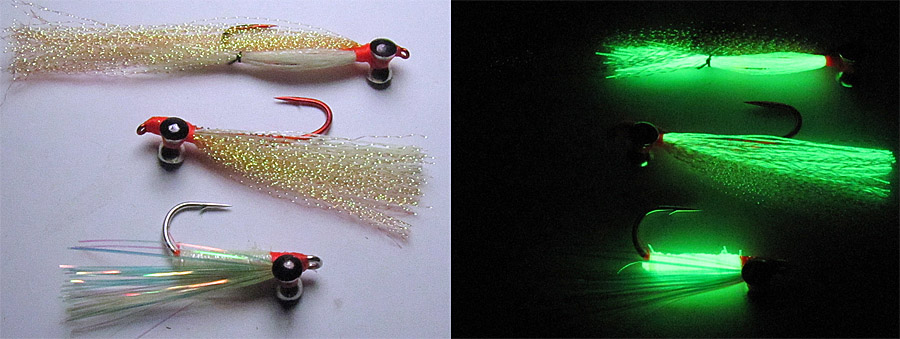
IMITATIONS: Don't be fooled by store-bought imitations. By this I mean if you decide to buy flies that resemble the Krill pattern, you must realize that 99% of those flies with "bead eyes" are actually hollow bead chain eyes that have very little weight. They look nice as part of the shrimp-like pattern but they fail on the most important objectives of fishing the Krill Killer as you will read below. ANATOMY OF THE FLY:
OK, perhaps that is a bit dramatic. LOL. But what I want to provide here are two observations for you to consider in your quest for the World Class Alaskan Sockeye Salmon. The first video was footage taken on the Russian River a few days before the sockeye salmon season opener on June 11, 2014. Pay special attention to just how wide a salmon opens and closes its mouth while swimming. Now think about the notion many non-believers have that the only way to legally hook a sockeye is to line them or drift your leader into their open mouth and then jerk to set the hook. Yeah good luck with that! How many casts and drifts would you have to make to have that leader slip between those jaws that are just a HALF INCH apart? And in the Kenai and Kasilof rivers, those are MIGRATING fish that provide you with ONE CAST per fish and then they are past you. So fishing a fly that a lot of those fish will want to try and take away from you is smarter fishing, don't you think? Instead of trying to drop a wooden clothes pin in the mouth of a milk bottle while standing on top of a step ladder, why not present some tasty morsel that will entice that fish to WANT to grab it?
But you hook that fish in the BACK or tail or fin and guess what? Its this fish's worst nightmare of a seal, or shark, or bigger fish trying to EAT it. And that is why snagged sockeye go ballistic when snagged in their bodies. Their reflex is to escape the pain they equate to a predator grabbing them. I suspect that these salmon probably have a tough mouth and fewer nerve endings meaning less sensitivity to a hook in their jaw. Watch the last video for an example of what happens when you back off the pressure on a mouth-hooked sockeye. And this last video is just some footage showing why this is a world class fish deserving of the highest respect. All caught on the KENAI KRILL KILLER too. Same fly as a few days earlier in the video above. :-) And in fact that same fly is still on my fly rod waiting on the first slug of Kenai Reds this season. 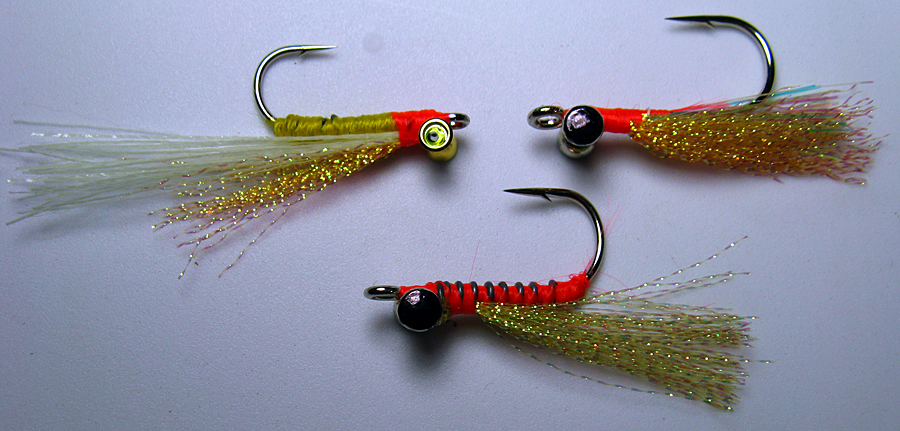 Good Luck, Good Fishing, and Always Keep Your Hooks Sharp~! -Klondike Kid-
All Content Copyright © 1996-2015 |

